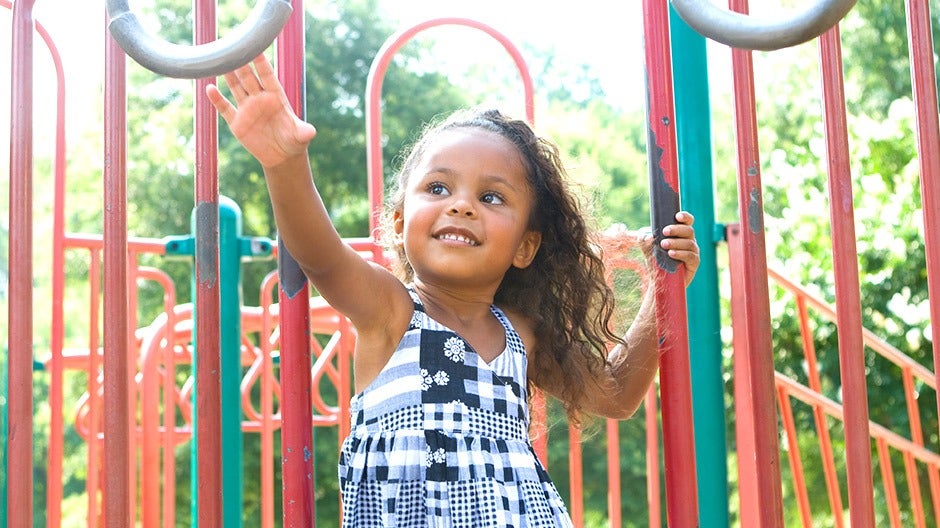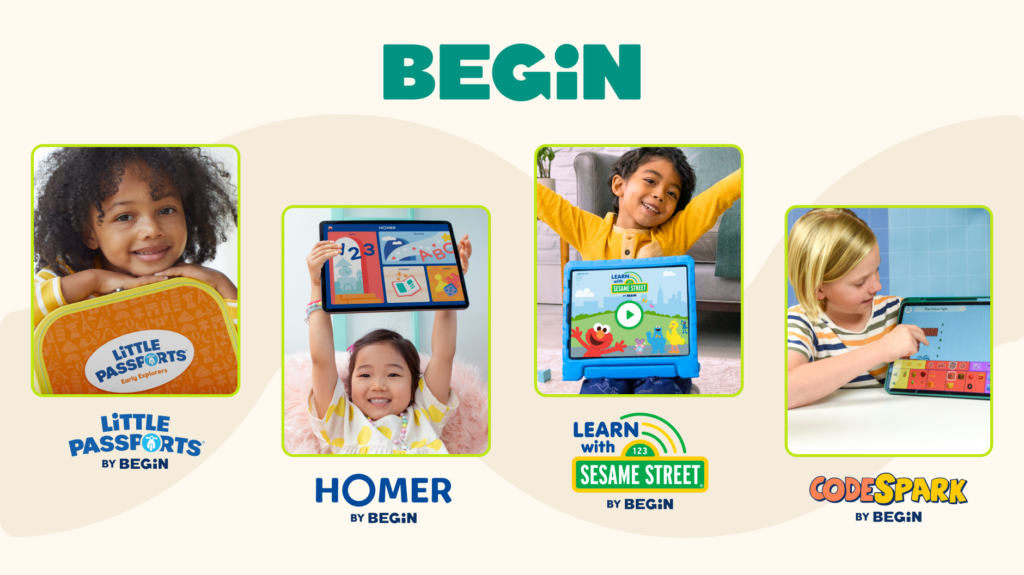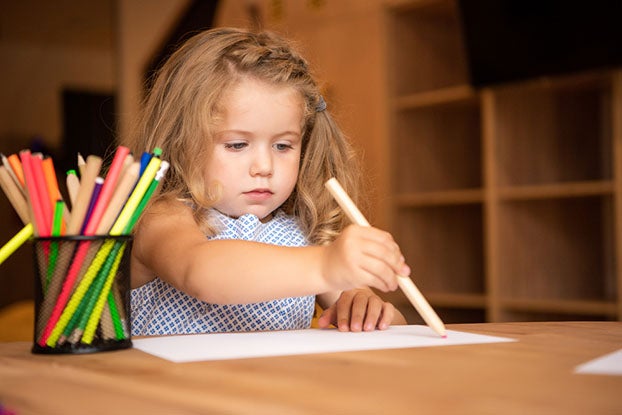Confidence encompasses two things:
- Trust that you can do something
- Belief that if you make a mistake, you can try again.
Building confidence in childhood sets the foundation for success in school, relationships, and exploring dreams. It also helps your child nurture a positive self-image and feel empowered to take risks that will enable them to grow.
Looking for ways to make it happen? We’ve got some great tips and activity ideas to help you nurture your child’s confidence.
The Short Cut
- Confidence is a key area of developing Character, one of the 5 C’s at the heart of the Begin Approach to thriving in school and life
- A growth mindset lays the foundation for building confidence and self-esteem
- A big part of being confident is the belief that making mistakes is an important element of learning
- A play-based learning membership can help kids develop the 5 C’s, delivered at the right time and in the right way for every child
Why Confidence Is So Important in Kids

Kids who are confident are more willing to take creative risks and advocate for themselves. They’re also more comfortable being themselves—at home, in public, at school.
In many ways, confidence empowers and enables all of the other skills we want our kids to learn. (Building skills helps develop confidence, too.) If a child has a positive feeling about who they are, they’re more likely to feel stable and safe, which makes it easier for them to learn.
Being confident also allows kids to build better relationships with themselves and everyone around them. They’re not afraid to share their opinions and ideas. They’re less likely to be insecure and threatened by other people’s strengths. All of this helps them face life challenges more easily.
5 Positive Parenting Strategies for Building Self-Esteem in Kids
So what are some ways you can build confidence in your kids?
1. Model Confidence
Show your child what it looks like to believe in yourself.
If you can practice positive self-talk (out loud, where your kids can hear it) and tangible preparation (like practicing basketball shots if you’re playing in a parents’ league or studying vocabulary words if you’re taking a language class), you’ll be demonstrating two of the most important components of confidence.
And if you don’t succeed at whatever you’re attempting to do? Good!
Failing is an essential part of being human. It happens to you, and it will happen to your child too.
If they see you fall short of your goal, don’t be afraid to show them how you feel. Expressing feelings like sadness gives you the chance to model how to move through them.
Then you can make adjustments, try again, and voilà!—you’ve given your child a perfect example of acting with confidence.
2. Praise Your Child’s Mistakes and Failures
Even if your child sees you making mistakes, it may be hard for them when they do the same. This is true for everyone, but especially for kids who have low self-esteem and kids who are shy or sensitive.
Let your child know how proud you are when they try something new. If you focus on their effort, you’re helping them internalize the importance of those two character traits.
And it’s okay to praise your child when they do succeed too! In fact, consistently focusing positivity on their perseverance and then praising them when they finally succeed will reinforce the important link between trying and accomplishing their goal, especially when you emphasize how proud you are of the work they put in (vs. the final result alone).
3. Encourage Your Child to Find Their Passion
It’s not too early to help your child find what they love to do or what they love to learn about, such as dinosaurs, space, or animals. Try to notice when your child is especially fascinated by something and see if you can make it easier for them to explore.
Becoming an expert in something begins an identity-building process that’s central to promoting a positive self-image. Putting in hard work and getting better and better also provides a definite self-esteem boost.
Ask your child questions about their passion. Let them know they’re teaching you something new. Feeling knowledgeable is empowering.
4. Find Ways for Your Child to Feel Responsible
Give your child an age-appropriate job in your home.
Maybe they can set the table every night. Or hold the dustpan when you sweep. Or help fold or sort the laundry.
To make the chore more doable, if you give them a task that has a few parts, break it down and demonstrate each one. Or do it together a few times before you turn it over entirely to your child.
Being an integral part of chores allows your child to feel a sense of independent agency (I can do this myself) and connection to the family.
It feels good to help! Even if your child resists it at first, don’t give up. They’ll eventually feel valued for their contribution.
5. Set Your Child Up for Success Sometimes
Making mistakes with no sense of forward progress can be hard for your child, especially if they’re highly sensitive.
You may notice them feeling frustrated when they fail and as a result, beginning to lose some of their self-confidence. If this is the case, give them opportunities to do something you know they can get right. Adding “wins” to their experience bucket gives them a way to recharge and then reset.
Once you see their confidence on the rise, you can go back to nudging them to take on more challenges!
3 Confidence-Building Activities for Children

1. Outdoor Exploration
All of the things that your child does outside, from walking to running to playing on the playground, give them the opportunity to strengthen their physical abilities.
Feeling strong is empowering. When your child feels like they can depend on their body, they are more apt to take on challenges. These challenges boost confidence and self-esteem.
What You Need
- Your child
- The outside world (neighborhood playground, local park, etc.)
What to Do
- Put on shoes and outerwear if it’s cold outside.
- Set age-appropriate boundaries (“Stay where you can see me,” “Stay between that tree and that picnic table,” etc.).
- Go play!
That’s it! If your child has lots of time for free play outside, they’ll have opportunities to explore different things and develop new skills.
Tips
- Climbing is an especially powerful outdoor activity for building confidence because it challenges your kid’s mind as well as body. It requires many skills: figuring out where to place their hands and feet, strategizing the best way to go, balancing, gripping, scrambling—there are many ways to play!
- Scavenger hunts build exploration into your child’s outdoor play. Give them a list of things to find or activities to do. You can even take pictures of them accomplishing each item on the list.
- Volunteering in the neighborhood gives your child the experience of providing something valuable to someone else. Helpful activities like raking leaves and pulling weeds give your child an opportunity to contribute to their community. This sense of purpose makes them feel capable.
2. Affirmations
Thoughts like “I’m so bad at that” or “I’ll never be smart like her” are common, even in kids.
But if they become too frequent or the default lens through which your child sees themselves, they may stop trying new things. And they may begin to experience stress.
Studies show that self-affirmations can be beneficial to well-being and academic success in older kids. It’s a good skill to start working on when they’re young!
Try a “two positives” approach if your child makes a negative self-statement:
- Ask them to think of two positive things about themselves. (Brainstorm with them if they need help.)
- Have your child say them a few times out loud.
- Write them down so you can remind your child of their strengths later.
This can help your child see that just like everyone else they’ve got strengths and challenges. Seeing the balance of the two gives them the power to choose where they focus.
Tips:
- Make sure you’re helping your child come up with affirmations that have substance. Empty affirmations (like “I’m so awesome”) probably won’t shift any stuck negative thoughts for your child. But finding something specific, timely, and valuable (like “I’m kind to my brother by sharing my toys”) can.
- If your child can’t think of anything positive to say about themselves, you can gently guide them by asking a few questions, like “What do you love to do?” or “Who do you care about?”
- Hearing someone else highlight their positive qualities can boost self-esteem too. If your child is struggling to affirm themselves, you can do it for them.
3. Make a “Yet” Poster
Having a fixed mindset means believing that what you can do right now determines what you will always be able to do.
For example, a kid may think they can’t learn to ride a bike because they can’t ride one now. The belief is like a wall. It keeps new things out.
A growth mindset creates a door in that wall. A kid can start to believe that with effort, strategy, and grit they can improve their abilities.
Even if a task isn’t easy and they’ll make mistakes, they believe they have potential.
One fun and effective way for your child to explore their potential is to change the idea of can’t into yet. So “I can’t ride a bike” turns into “I can’t ride a bike—yet.”
What You Need
- Piece of paper or poster board
- Markers
- Sticky notes or other paper
- A place to hang the poster
What to Do
- Brainstorm things your child wants to do, but can’t quite yet.
- Have your child write them down on the paper (or do it for them if needed).
- Every time your child does a “yet” activity they can check it off or write the date!
Variations
- Write your ideas on sticky notes and move them from one part of the poster to another once your child has accomplished a goal.
- Help your child write a “yet” letter to themselves. Brainstorm what they can do, what they can’t do yet, and some encouraging thoughts that would inspire trying something new. Your child can pick one thing from the “yet” list and write a letter inspiring themselves to give it a try. If your child isn’t writing yet, they can draw a picture instead.
- Create a “yet” jar. Write down the activities they don’t do yet and put them into a jar. Then your child can pull one out and try that activity whenever they want to!
- Design a “yet” crown. Ask your child to draw the activities they can’t do yet on small pieces of paper. (It can be fun to make them into jewel shapes, like diamonds!) Cut out a paper crown and attach the drawings. Have your child wear it when they try something new. You can also make a “victory” crown and your child can move their “jewels” from one crown to the other once they’ve had a success!
Building Confidence with Begin

Becoming a confident kid doesn’t happen overnight. It takes years of practice and progress. If you don’t see your child’s positive self-esteem right away, remember they are learning. It just takes time.
And we can help! Our learning membership grows with your child, providing age- and stage-based opportunities to build confidence. They can learn early social-emotional skills with Sesame Street friends, work on reading and math to get ready for kindergarten, explore the world through art and science, and more!
Take our quiz today to see which stage of the membership fits your child best!













